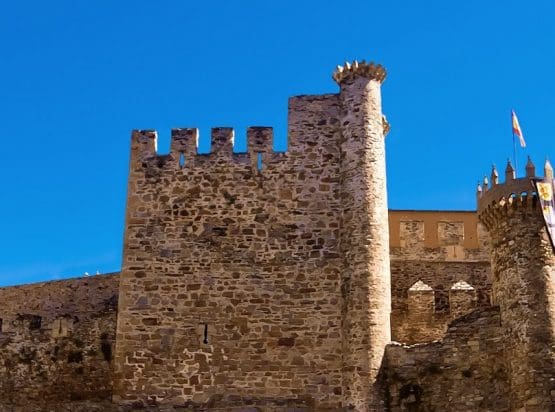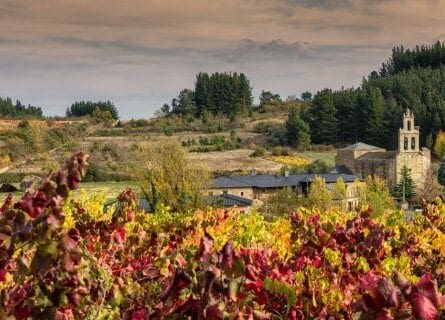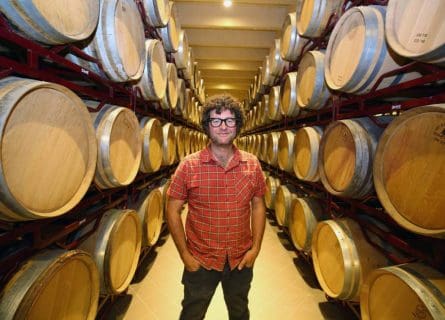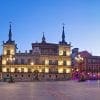Immerse yourself in Ponferrada's vibrant flavors and uncover hidden culinary gems with our expert insider guides. Plan an unforgettable trip today!
Read more
EXPLORE ALL OUR CASTILLA Y LEON WINE REGIONS GUIDE
Last updated: October 11, 2024
Isolated, mysterious, beautiful: Bierzo is the region that oenophiles dream of discovering. This verdant DO in northwestern Spain, whose hilly, castle-studded landscape is hemmed in the mountains between Castilla y León and Galicia, was virtually unheard of in the 20th century. Yet this former Roman stronghold is now making waves, propelled by significant investment and a surfeit of critical hype. It is a region where mineral-rich slate soils, a continental climate, and intrepid winemakers have come together to create truly memorable red wines.
However, aficionados of Ribera del Duero may find the wines of Bierzo slightly baffling. Indeed, northwestern Spain forged its reputation as a producer of robust, concentrated reds; there is still a healthy market for such wines. Yet a growing firmament of younger consumers seek bottles that refresh rather than merely impress – a cue for Bierzo to conquer the hearts and minds of Gen Y and Z. The region’s USP is the Mencia grape, responsible for Spain’s most aromatic, balanced, and ethereal red wines. The complete antithesis of an overoaked fruit bomb. And, increasingly, a major player in the export scene.
Discover more about Spanish Wine
Castilla y León is a picturesque outdoor museum: an ancient land that contains vital clues to Spain’s fascinating and turbulent past. The heart and soul of Bierzo is Cacabelos, a buzzing market town and an important stop along Spain’s legendary pilgrim’s route, the Camino de Santiago (St. James Way, the religious journey that has taken place for many centuries).
Meanwhile, large towns like Ponferrada and Vilafranca del Bierzo are chock full of Templar castles, medieval monasteries, and once-extravagant palaces. But the most essential clue resides in Las Médulas, a Roman gold mine outside Ponferrada.
A maze of tunnels burrowed in the ruddy red rock, Las Médulas was built after this once-great civilization arrived in the Iberian Peninsula in the 3rd century BC. However, the invaders took 200 years to completely subdue the peninsula, divided into three provinces: Tarraconensis, Lusitania, and Baetica. Amazingly, many relics from this era remain intact today, not least the majestic aqueduct of Segovia.
Rise of Al Andalus
However, the empire’s hold over Spain was fragile in the 5th century. In 415, the Visigoths established a prominent court in Barcelona; Vandals and their allies crossed the Pyrenees into Catalunya in 409. By 476, the Western Roman Empire had collapsed into a multitude of fractured kingdoms contested by a number of rival powers.
The Visigoths enjoyed a short-lived reign from their capital in Toledo before the Moors invaded Andalucia in 711 AD. The arrival of Arab and Berber invaders from North Africa gave rise to an incredible civilization known as ‘Al Andalus.’ Yet the caliphate (center of Islamic power) eventually fragmented into smaller, self-governing provinces while Christian enclaves started fighting back.
By the 11th century, Fernando I united the infant kingdoms of Castilla and León; however, the union was not consolidated until the early 1200s. Nevertheless, the kingdom of Castilla y León played a decisive role in reconquering Moorish territory; El Cid, the scourge of the Moors, was born in the region. Finally, in 1492, the last Islamic stronghold collapsed as Columbus discovered the New World.
Flourishing Viticulture and Economic Influence
After that, this part of central Spain assumed a major role in the country’s affairs. Viticulture, an important staple since Roman times, flourished along the banks of the Duero River; the monasteries assumed responsibility for wine-growing during this period. Meanwhile, wealth pouring in from the wool trade and New World peaked in the 16th century.
However, the following centuries witnessed political crisis after political crisis, reaching its zenith during the implosion of Spain’s Second Republic. After a brutal civil war, the fascist dictator Francisco Franco abolished democratic government in 1939, ruling Spain with an iron fist.
However, democracy was restored in 1977, following the dictator’s death in 1975. As a result, rustic wine co-operatives started to (thankfully) die out in the second half of the 20th century, replaced by private enterprises and investment. And yet, the spotlight of fame did not reach Bierzo until the early 00s.
Alvaro Palacios of Priorat (and his nephew Ricardo Palacios) put the region on the international map, drawn to the exceptional terroir and generous volume of old bush vines. They have inspired many winemakers to follow their lead – the crème de la crème of Bierzo now includes Dominio Tares, Prada a Tope (a whimsical winery known for its grape-based beauty products), Pittacum, Bodegas Estefania, Castro Ventoso, Bodega del Abad, and Paixar.

The vineyards of Bierzo are among the most beautiful in Spain. Located in a northwestern region of Castilla y León, the zone is sheltered by hills from the worst extremes of Galicia’s oceanic climate. It is also a Mecca for history buffs: several isolated villages high in the hills contain pallozas – ancient, pre-Roman stone dwellings thatched with rye. But, of course, what lured in Palacios and his contemporaries was the unique soils: slate and quartzite planted with scores of old vines, many of them centenarians.
The Privileged Slate Terraces of Bierzo
It is widely agreed that the most privileged climats (vineyard sites) are cultivated on picturesque slate terraces along the steep slopes of the Sil River valley, some with such marked inclination that mules are used for the grape harvest. At lower elevations, however, the soils contain a great deal of alluvial matter deposited by the river over centuries of erosion.
As a result, high altitude plots, rising to almost 1000 meters above sea level, benefit from moderate rainfall and the always welcome diurnal temperature variation (a significant temperature variation between day and night). This is the secret behind Bierzo’s success and growing reputation as Spain’s answer to Burgundy. Today, these exceptional soils produce wines with grace and finesse rarely glimpsed in the arid plains of Castilla y León. They are extraordinary.
Young winemakers – and outside investors – continue to flock to this achingly trendy region. Mencía is the star variety here, occupying nearly two-thirds of the total area under vine. According to the DO rules, this enigmatic grape must constitute at least 70 percent of the final blend – in practice, it is often much higher. Cultivated almost exclusively in northwestern Spain (especially in the Galician regions Valdeorras, Monterrei, and Ribeira Sacra), Mencia has only recently become a respected grape variety. In good hands, it reveals fresh fruity notes, smooth tannins, and an enviable reflection of the mineral-rich terroir.
Although known as a wine that shows very well in the first flushes of youth, some Bierzo producers have demonstrated its ability to age; just the right amount of oak can help add structure and depth. Yet too much new barrique will spoil the style. Finally, Bierzo is no one-trick pony: Godello electrifies the palate with its beautiful acidity and moreish tropical fruit.
Aging vs. Terroir
Meanwhile, the classification of Bierzo wines is a subject of constant debate. An official, DO-sanctioned hierarchy stipulates that Crianzas – red and white – must be aged for at least two years (six of those must be in wood). The Reserva tier requires three years of maturation: 12 months in oak and 24 months in bottle. Yet the highly respected and influential winemaker Ricardo Pérez Palacios has pushed for a more ‘Burgundian’ approach to classifying wines based on terroir and not the length of aging.
Unveiled in 2017, this terroir-driven hierarchy allows producers to label their wines as ‘village’ (made in a specific subzone of Bierzo) or ‘paraje’ (wines made from a single plot or area). It has been an enormous and unmitigated success, bolstering the region’s quality credentials and attracting significant attention from critics and journalists—which, of course, is the name of the game.

Ricardo Pérez Palacios is nothing if not ambitious. After joining the technical committee of the DO authority in 2014, he set out bold plans to revolutionize how Bierzo promotes its wines. No longer content to classify bottles according to the length of time in barrel, Palacios wanted to take the best elements of Burgundy’s iconic terroir pyramid and make it a part of local wine culture. As it turns out, the regulatory committee agreed!
Thus, from the 2017 vintage (the first wines were released a year later), Bierzo labels could mention the village where the vineyards were located, the subregion where the village is situated, or the specific lieux-dit (vineyard site) responsible for the fruit.
Transparency in Bierzo’s Wine Labels
The idea was to provide sommeliers and oenophiles with total transparency rather than ‘hiding’ the nuances of terroir and site selection in anonymous brands. So far, the trade has warmly welcomed the project, which recognizes that consumers increasingly demand authenticity and individuality in their wine choices. More reactionary elements within the region have doubts, but plenty of growers regard this as a seminal moment for Bierzo wines. They continue to push for a delineated Premier/Grand Cru hierarchy in the zone. Will it come to pass? Only time will tell.
is a white grape variety that is primarily grown in the northwest of Spain, particularly in the regions of Bierzo, Galicia, and Rueda. Known for its aromatic profile and bright acidity, this grape is often blended with other varieties but is increasingly being vinified as a single-varietal wine.
Discover Godello: Galicia's Exquisite White Wine Grape from Valdeorras. Unveiling the Delights of this Northwestern Spanish Varietal.
Find out moreMalvasia Bianca, a historical grape from Greece, now thrives in Sicily and the Aeolian Islands, producing unique sweet wines.
Find out morePalomino: The quintessential grape for Sherry in Andalucia, Spain's southern delight. Unearth tradition's essence in every sip.
Find out moreDiscover the irresistible allure of Cabernet Sauvignon—a worldwide favorite with robust, dark-bodied flavor. Unleash your wine journey today!
Find out moreGarnacha: Spain's Red Gem. Akin to Pinot Noir, it bridges terroir and winemaking, crafting captivating expressions.
Find out moreUnearth Mencía: Spain's captivating red gem. Original and alluring, it emerges from the shadows, captivating wine enthusiasts worldwide.
Find out moreMerlot is the most cultivated grape in Bordeaux and closely related to Cabernet Franc
Find out moreDiscover Tempranillo: Spain's iconic red grape. From Ribera del Duero to Toro, it yields concentrated wines. Explore its synonyms and unleash its prowess.
Find out moreThe gastronomy of northwestern Spain is rooted in history and tradition. Of course, you’ll find cutting-edge Michelin gastronomy in the major cities, but most residents prefer hearty flavors and the uncomplicated joy of seasonal ingredients cooked to perfection. In the case of Bierzo, the Atlantic supplies abundant fresh seafood, while the meseta (central plain) provides rich suckling pig and milk-fed lamb, roasted whole and stuffed with garlic. Mencia served with chuletas (milk-fed lamb chops) is up there with Spain’s greatest culinary experiences—pure, unadulterated heaven.

Immerse yourself in Ponferrada's vibrant flavors and uncover hidden culinary gems with our expert insider guides. Plan an unforgettable trip today!
Read more
Immerse yourself in León's vibrant flavors and uncover hidden culinary gems with our expert insider guides. Plan an unforgettable trip today!
Read moreIf you would like us to customize an exclusive luxury tour, contact us and let us know your travel plans. We offer luxury food and wine tours for private groups of a mininium two guests. In addition, all of our private, chauffeured tours are available year-round upon request.

